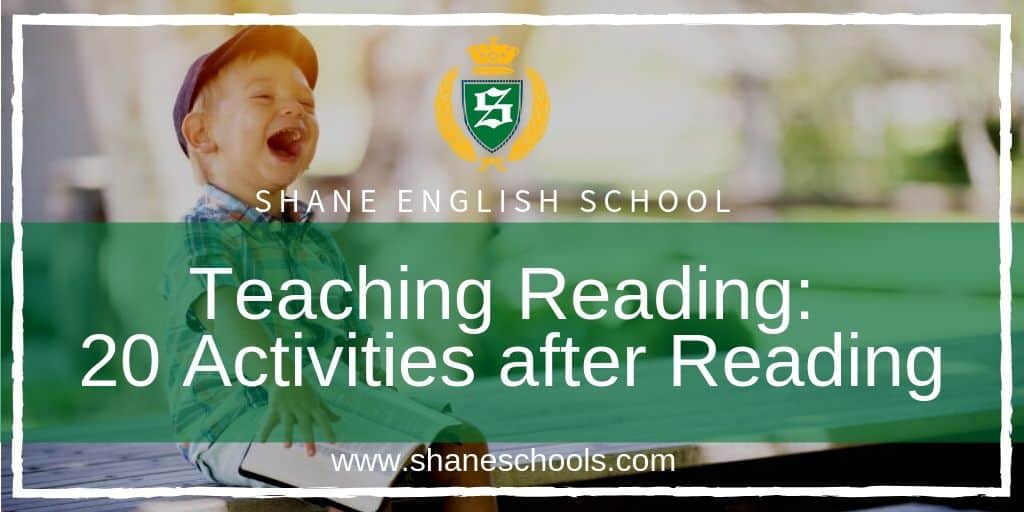Teaching reading does not end with the story. Here are some fun reading activities for building comprehension and improving retention. Having fun activities after the reading assignment is also a great way to reward reluctant readers. Add these 20 activities to reading classes to keep the fun going long after the book is finished.
15 Activities after Reading: Comprehension
There’s no point teaching reading if the students don’t understand what they have just read. These comprehension activities are great for reinforcing reading sessions and getting students to better engage in future readings.
- Ordering – Students put paragraphs, pictures, list of events, etc., in the right order.
- Matching – Students match pictures and sentences.
- True or False Quizzes – Use a simple quiz to test for comprehension. This can be written or spoken in quiz show-style games.
- Students’ own quiz – Students form 3 or more teams and come up with their own questions to ask other class teams. Teams have to ‘buzz in’ to answer.
- Students finish sentences – Students get half of a sentence from the reading then complete it.
- Match characters to their statements – Give students examples of characters’ dialogue and match the source. Again, this can be written or spoken, which can be made into a game.
- Unscramble and write sentences – The teacher takes a sentence and places the words out of order. The students then re-order the words into correct sentences. An advanced version of this activity leaves out simple words like articles and prepositions.
- Students correct sentences detailing events – Students correct a sentence from the story. Or students use their imaginations to change the story to their liking.
- Questions from pictures – Students answer simple questions from pictures of events in the story.
- Basic gap-fill – Gap-fill a summary of the story. Blank out every nth word, important vocabulary, character name, etc., and let the students complete the passage.
- Change the story gap-fill – Students gap-fill a summary of the story with key words blanked out. As part of the activity, students get to change characters or events to change the storyline to their liking.
- Sentence matching – Each student gets a sentence’s ending or beginning on a scrap of paper. Students mingle and say their ending or beginning until they find a match. When they find a match, students return to their seat to write the sentence. Extension: This activity would work best with key events. Once all the students match their sentences, the whole class uses them to write the story. Students listen to all the sentences and re-write the whole passage in the correct order.
- Sentence endings and beginnings – Write some endings and beginnings on a worksheet. The matching endings and beginnings can go up around the classroom. Students write the full sentences on the worksheet. They cannot take the endings and beginnings off the wall, they must read and remember.
- Was it in the story? – Give the students some sentences. Half are in the text, half are not. Students guess (they should know!) which were in the text.
- True or false quiz – Give the students some statements about the text. Students decide which are true or false.
Plus 5 More Activities after Reading: Character Analysis
Some students are more dramatic and don’t always enjoy the passive reading experience. Luckily, teaching reading to more imaginative students is easy with these character analysis activities.
- Characters in different situations – Create a situation different from the story in the book. How would the characters behave in different environments? (i.e. The Tin Man going is shopping.)
- Student-student journalist interviews – A ‘newspaper reporter’ interviews a character (e.g. Dorothy from The Wizard of Oz, Betty from Betty’s Secret, etc.).
- Horoscopes – At an appropriate stage in the plot development, students write horoscopes for the characters predicting their future. At a later stage, these can be used to compare against the real events of the book. Did the horoscope prediction come true?
- Map relationships – Map out the relationship between characters.
- Character interviews – Students role-play an interview with one of the characters. Assign students the roles of the characters. The rest of the class prepare questions they would like to ask them. The students playing the characters must put themselves in the characters’ shoes to give suitable answers. Teachers, make sure the students have enough support to perform their roles. You could imagine that the interviews are taking place in a police station, on a TV chat show, or wherever seems appropriate. With a little imagination, it can be a lot of fun!
With these 20 activities at the teacher’s disposal, teaching reading no longer ends with the book. Students can use their imaginations (and other skills) to more fully engage with reading materials. Best of all, students can infuse a little bit of fun into reading comprehension and character analysis.
Not ready for post-reading activities? Check out these pre-reading activities. Or look at some of our activities to make reading more exciting.
A version of this article originally appeared in Shane English School’s Teaching English to Young Learners (TEYL) program, which is part of new teachers’ orientation.[

We're hiring!
With schools around the world, Shane English School always has exciting new opportunities to offer.


